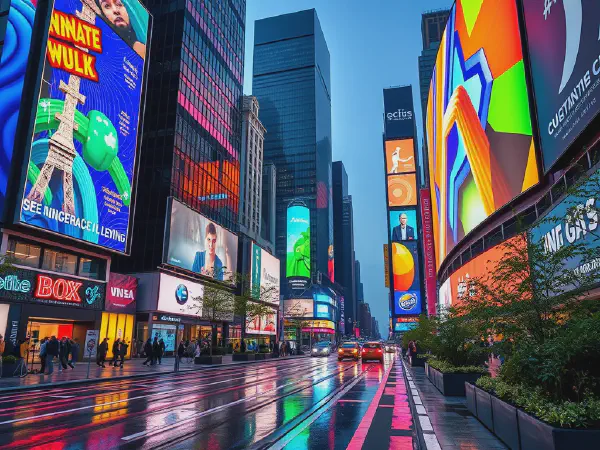Explore the Impact of Gigantic Signs on Modern Advertising

Gigantic Signs: Capturing Attention on a Grand Scale
Gigantic Signs are a powerful form of advertising that transcend traditional marketing by captivating audiences through their sheer size and visibility. These larger-than-life displays are designed to grab the attention of consumers, often becoming iconic landmarks in urban landscapes. The strategic use of Gigantic Signs can enhance brand awareness and create lasting impressions, making them a vital part of modern marketing strategies.
From towering billboards to breathtaking digital displays, Gigantic Signs come in various forms, each playing a crucial role in how brands communicate their messages. These signs not only serve the purpose of advertising but also contribute to the aesthetics of their surroundings. As cities expand and competition intensifies, the innovative designs and placements of Gigantic Signs have evolved to meet the demands of an ever-changing marketplace.
The significance of Gigantic Signs extends beyond mere promotion; they reflect cultural trends and societal values. Their ability to evoke emotion and provoke thought makes them a unique medium for storytelling. In the digital age, with the advent of technology, the transformation of traditional signs into modern, interactive experiences has heightened consumer engagement, making Gigantic Signs more relevant than ever.
In this article, we will explore various aspects of Gigantic Signs, including their types, strategic placement, impact on consumer behavior, design trends, and environmental considerations. By understanding these elements, businesses can leverage the full potential of Gigantic Signs to enhance their marketing efforts and connect with their audiences on a profound level.
Gigantic Signs have an undeniable presence in the advertising world, making them essential tools for marketers looking to stand out. As we delve deeper into this subject, it becomes clear that the power of Gigantic Signs lies not only in their size but in their ability to create connections and influence consumer perception.
Types of Gigantic Signs
One of the most recognizable types of Gigantic Signs is the billboard. Billboards have evolved significantly from simple painted advertisements to sophisticated digital displays that can change messages in real-time. Their strategic locations along highways and busy intersections ensure maximum visibility, making them effective for both local businesses and national brands.
Digital Gigantic Signs now dominate urban environments, utilizing LED technology to showcase vibrant visuals and animations. These signs can engage consumers with dynamic content, allowing brands to update their messaging instantly to reflect current trends or promotions. The interactivity of digital signs also offers opportunities for audience participation, enhancing engagement.
Inflatable Gigantic Signs present a unique and playful approach to outdoor advertising. Often seen at events or retail stores, these signs attract attention through their unusual shapes and sizes. Their lightweight nature allows for easy transportation and setup, making them a popular choice for temporary promotions.
3D Signs and Logos elevate Gigantic Signs to a new level with their dimensional aspects. These signs can incorporate lighting and movement to create a captivating experience for viewers. Utilizing advanced materials and design techniques, 3D signs can effectively communicate a brand's identity and message in memorable ways.
Strategic Placement of Gigantic Signs
Successful implementation of Gigantic Signs relies heavily on strategic placement. The most popular locations for these signs include high-traffic areas such as city centers, highways, and entertainment districts. By positioning signs where foot traffic and vehicle congestion are highest, brands can ensure their messages reach the most potential customers.
Several factors influence the placement of Gigantic Signs, including target audience, visibility, and regulatory restrictions. Understanding the demographics of an area can help brands choose locations that align with their marketing goals. Additionally, factors like sight lines and environmental conditions play a crucial role in determining the best placement for maximum exposure.
Legal considerations are paramount when it comes to Gigantic Signs. Many cities have strict regulations governing the size, brightness, and placement of signs to prevent visual clutter and maintain urban aesthetics. Advertisers must navigate these legal landscapes to ensure compliance while still making a significant impact with their signage.
Case studies of successful placements highlight the effectiveness of Gigantic Signs in driving brand recognition and sales. Analyzing the impact of iconic signs, such as the famous Hollywood sign or Times Square billboards, provides valuable insights into how strategic placement can transform a simple advertisement into a cultural landmark.
Impact on Consumer Behavior
The psychology of large advertisements, like Gigantic Signs, suggests that size equates to prominence. Consumers are naturally drawn to larger displays, perceiving them as more credible and noteworthy. This psychological response can lead to increased brand trust and consumer interest, making Gigantic Signs a powerful tool for marketers.
Attention-grabbing techniques employed in Gigantic Signs include vibrant colors, bold typography, and unconventional shapes. These elements are strategically designed to cut through visual noise and capture the viewer's focus. The use of humor, curiosity, and emotion in messaging can further enhance the effectiveness of these signs in attracting attention.
Gigantic Signs significantly influence brand recognition by creating visual associations in the minds of consumers. The repetition of seeing a brand in prominent locations helps strengthen memorability, making it more likely for consumers to choose that brand when making purchasing decisions.
Consumer responses to Gigantic Signs often include increased engagement and interaction. The spectacle of a massive, creatively designed sign can provoke conversations among viewers, leading to organic word-of-mouth marketing. Furthermore, social media has amplified the impact of Gigantic Signs, as consumers share their experiences and photos, extending the reach of the original advertisement.
Design and Creativity in Gigantic Signs
Innovative design trends in Gigantic Signs continually evolve to keep pace with changing consumer expectations. Designers are now experimenting with 3D effects, augmented reality, and interactive elements to create immersive experiences. These trends not only make the signs aesthetically appealing but also enhance their functionality in delivering brand messages.
Materials used for durability are critical in the production of Gigantic Signs, as they must withstand various environmental conditions. The use of weather-resistant materials and advanced technologies ensures that these signs remain vibrant and eye-catching over time, allowing brands to maintain their investment.
Color psychology plays a significant role in the design of Gigantic Signs. Different colors evoke specific emotions and associations, influencing consumer behavior. For example, warm colors like red and yellow tend to grab attention more quickly, while cooler colors can promote a sense of calm or trust. Brands carefully select color palettes to align with their desired message and audience perception.
Collaboration with artists brings a unique creative dimension to Gigantic Signs. By integrating artistic expression into signage design, brands can elevate their messaging and create a lasting impact. Artist collaboration can also generate community interest, drawing people to experience the sign as a piece of public art rather than just an advertisement.
Environmental Considerations
As the significance of sustainability grows, environmental considerations in signage production have become increasingly important. Brands are now seeking eco-friendly materials and practices to minimize their carbon footprint. This shift towards sustainability can enhance brand image and appeal to environmentally conscious consumers.
Energy efficiency of digital signs is another critical aspect of environmental consideration. The development of energy-saving technologies and practices allows digital Gigantic Signs to operate with minimal energy consumption, reducing their impact on local power grids and overall energy waste.
Recycling and waste management play a significant role in the lifecycle of Gigantic Signs. Brands are encouraged to adopt responsible disposal practices for old signage and use recyclable materials whenever possible. This commitment to sustainability not only benefits the environment but also resonates with consumers who value corporate social responsibility.
The impact of Gigantic Signs on urban aesthetics is a double-edged sword. While they can enhance the visual appeal of a city and contribute to its cultural identity, poorly designed or excessive signage can lead to visual clutter. Therefore, a balance must be struck to ensure that Gigantic Signs enrich urban landscapes while respecting the environment and community aesthetics.
